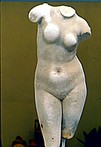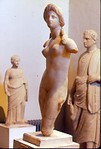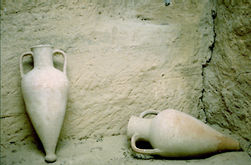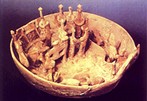SANCTUARY OF APHRODITE
Palaepaphos, Old Paphos, was one of the most celebrated of pilgrimage
centres of the ancient Greek world, and once an ancient city-kingdom
of Cyprus. Here stood the famous Sanctuary
of Aphrodite, the most ancient remains of which date back to the
12th century BC. The glorious days of the sanctuary lasted, till the
3rd-4th century AD. The Museum, housed in the Lusignan Manor, contains
many interesting finds from the area. Excavations continue on the
site of the sanctuary, the city and the necropolis.

 The
cult of this divinity and the magnificent costumes of her priestesses
are illustrated by precise iconographic evidence from the 7th century
B.C. onwards. A number of terracotta figurines were found in Palaepaphos
on the site of the temple, depicting a woman in an adorned long low-necked
robe the woman is lifting her arms up in a ritual gesture, like a
divine majesty, a goddess or a priestess. Numerous other archaic figurines,
wearing lavish and colourful costumes, sometimes with a long stole,
ornated with rich jewels, necklaces with pendants, earrings, bracelets,
are all indications of a magnificent cult. On archaic vases richly
dressed women are also represented, wearing the stole, or a long scarf
or belt probably servants of the goddess, or priestesses worshipping
the tree of life or walking among the sacred trees, holding flowers
or animals or birds.
The
cult of this divinity and the magnificent costumes of her priestesses
are illustrated by precise iconographic evidence from the 7th century
B.C. onwards. A number of terracotta figurines were found in Palaepaphos
on the site of the temple, depicting a woman in an adorned long low-necked
robe the woman is lifting her arms up in a ritual gesture, like a
divine majesty, a goddess or a priestess. Numerous other archaic figurines,
wearing lavish and colourful costumes, sometimes with a long stole,
ornated with rich jewels, necklaces with pendants, earrings, bracelets,
are all indications of a magnificent cult. On archaic vases richly
dressed women are also represented, wearing the stole, or a long scarf
or belt probably servants of the goddess, or priestesses worshipping
the tree of life or walking among the sacred trees, holding flowers
or animals or birds.

There are also representations of hierodoules (sacred servants) in
the sacred gardens which we know surrounded the sanctuaries. One specific
bowl even depicts erotic scenes in the gardens, making reference to
the sacred prostitution mentioned by Herodotus. A large archaic amphora,
the Hubbard amphora in the Cyprus Museum, shows on both sides scenes
of the cult: on the one side, there is a sacred dance of young women
holding branches and accompanied by a lyre player and, on the other
side, between a sphinx and a bucrane, symbolising the sacred, precinct,
a priestess sitting on a throne, drinking from a kind of narghileh
some substance served to her by a sacred servant, a scene evoking
perhaps divination practices. A great number of other terracotta figurines,
laid as offerings in places of worship, depict a world of musicians,
women playing the tambourine, or offering a bird, a flower, a dish
of sweets. But next to these richly dressed figures, we find also
figurines of the nude deity, pressing their breasts, another reminder
that the goddess retained her oriental character of fertility goddess.

The first millennium B.C. seems to have been the age of gold of the
cult of this great Cypriote goddess, who had on the island a number
of other sanctuaries. During the archaic period, Golgoi, situated in
the centre of the island (the region of Athienou-Idalion) was another
of her sacred sites; however, archaeological findings have brought to
light only few significant vestiges. She had consecrated sites of worship
in Kition, Arsos, Achna, Amathus, Kythrea, Tamassos, Idalion, Lapithos,
Salamis and others.
The rite of sacred prostitution was
practised, according to Herodotus, 1.105. 2-3, in her
sanctuary in Paphos. Every girl had to come once in her
lifetime to the sanctuary and made love to a stranger.
The girls would sit in the sacred gardens with a crown
of rope on their head. They waited for a man to choose
them by throwing at their feet an offering, no matter
how small, for this offering was sacred, and say the
words: “I invoke the goddess upon you”. No girl had the
right to refuse. All the girls that were beautiful, says
Herodotus, finished quickly, but the ugly ones had to
wait as long as three or four years... According to
Clement of Alexandria, mysteries were celebrated in the
sanctuary and the initiated received an amount of salt
and a phallus, in exchange for which they offered a coin
to the goddess. Divination was another practice. The
temple of Palaepaphos, a site of great accumulated
wealth, was still flourishing under the Ptolemies who
dedicated numerous statues.
During Roman times, the
sanctuary placed under the patronage of the emperors,
remained one of the most celebrated temples in the
ancient world. Coins from Roman times illustrate the
sanctuary of Paphos, an edifice in three parts in the
cella of which there was a sacred stone in the shape the
goddess was still worshipped. Pilgrims used to flock in
procession and a big festival took place during which
there were games as well as musical and literary
competitions to pay tribute to the goddess. Divination
was still practised and emperor Titus went to consult
his oracle. The cult of Aphrodite was maintained in
Cyprus at least during the first three centuries of our
era, even while Christianity was spreading.